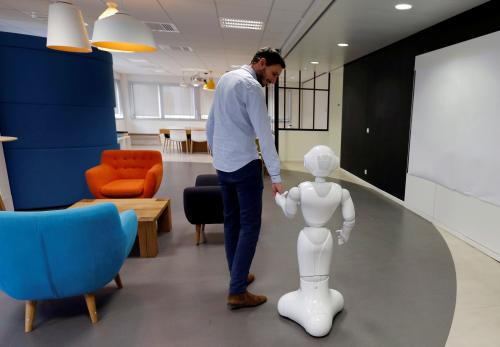In the decade since the Great Recession, governments have used fiscal policy to prop up flagging domestic demand. This response has been considered appropriate because the shock was seen as temporary. But this attention to demand-side weaknesses may have distracted governments from attending to supply-side gaps that have been widening with the acceleration of technological change and artificial intelligence.
Policymakers should start paying more attention to what’s called structural fiscal policies, that is, changes in both public spending and tax collection to aid the expansion of the productive potential of economies. As laborsaving technologies flood the market, delays in doing this could mean that workers pay a stiff price, while consumers do not realize many of the benefits.
Why a shift to structural fiscal policies is needed
We think the time to address the supply side is now for three reasons:
- First, cyclical weaknesses have been largely overcome. High government debt and limited fiscal space also call for a change of strategy.
- Second, the fiscal efforts over the decade have done little to address the structural impediments to growth. There has been either a slowdown in productivity growth since 2008 or a return to the modest pace of change of the 1990s.
- Third, inequality has been trending up in many countries, despite much progress in raising living standards across the developing world in the last few decades.
Changes on the spending side: Build human capital and strengthen markets
The first priority needs to be the reform of education systems. Public education spending across the globe amounts to a staggering $3.7 trillion every year. What has that spending bought? The results of this large education tab match neither the aspirations of youth, nor the imperatives of the market. To be sure, efforts by governments to improve access to education have been a success. Primary enrollment is nearly universal, and secondary enrollment has increased from 40 percent in 1970 to 75 percent by 2015. But student learning is another matter altogether. The World Bank’s most recent World Development Report, focused on education, shows that in India and Ghana—countries that are doing quite well—80 percent of second grade students cannot read a single word of text. Even in the richer economies of the Organization for Economic Cooperation and Development, where governments spend about 5 percent of GDP on education and households another 5 percent, 1 out of 8 students who were 15 years old was functionally illiterate in 2015. The second priority is a new way of thinking about helping those who haven’t found work. A new kind of unemployment insurance—that facilitates an upgrade in skills to help workers catch up with the rapidly changing demands in the labor market—should be on the agenda of any progressive government. Government-run social protection and insurance are likely to be inadequate to help the unemployed maintain or upgrade their skills in times of technological disruption. Insurance schemes need to be more flexible and provide none of the disincentives of some traditional schemes. Consider, by contrast, a small tax incentive to workers to facilitate the creation of transitional unemployment accounts, supported by modest tax breaks and corporate contributions. For some, an introduction of universal basic income (UBI) provides the answer to the potential technology-fueled unemployment. Calculations by the International Monetary Fund suggest that providing an UBI of one-fourth of the median income in advanced economies would cost about 7 percent of GDP a year. Most likely, even a modest UBI would be politically challenging to implement. Capital and skill intensity of production have been rising due to technological breakthroughs, and regulatory policies have not kept up. The result is that competition has been weakening. Reduced competition inevitably leads to increased concentration within industries, a smaller number of leading companies in many industries, and higher profit margins. Governments will have to adjust their fiscal and regulatory policies, reduce the state’s own footprint where possible, and make it easier for markets to be created and contested. Often, market solutions to market dominance are faster, cheaper, and less distortionary—especially compared to situations where governments play catchup with the relentless pace of technological change. Avoiding special interest groups’ influence over regulators may get harder in times of technological disruption, but it also becomes even more essential.
Changes are needed on the tax side as well
The first change involves targeted tax cuts, even to levels where taxes are negative. In high-income economies, the progressivity of the tax system could be improved by introducing tax cuts for middle-income families and larger negative tax rates for low- and middle-income families. An example of the latter system is the earned income tax credit in the United States, available to low- to moderate-earning working individuals or families. The maximum annual tax credit for a family with two children is about $5,600. This is just a tenth of the U.S. median household income, a level that may be overly modest in case of large income shocks. Other countries considering such tax credits might shoot for higher ratios. The second change is to reduce both tax rates and exemptions. In many developing countries, high marginal tax rates co-exist with large tax exemptions, creating administrative difficulties collecting even modest levels of public revenues. Simplifying tax structures while reducing the number and scope of exemptions may be the most appropriate way to raise adequate government revenues for public goods without higher tax rates. Taxing robots is another idea that is being talked about by economists, entrepreneurs, and politicians. We think such ideas are unreasonable. Even if a robot tax can be implemented, such a tax would slow innovation while doing nothing to bolster the skills of the people whose jobs may be changed or destroyed because of the automation. Goals and policies have to be kept aligned: We want more innovation not less, less back-bending work not more, and more not fewer creative jobs. Taxing every laborsaving device will not help get to these goals.








Commentary
A new fiscal policy for a world of accelerated change and artificial intelligence
March 7, 2018